 What fruit has more potassium than a banana and is sometimes called an “alligator pear?”
What fruit has more potassium than a banana and is sometimes called an “alligator pear?”
Believe it or not, it’s the avocado!
And, yes, you read right…it is a fruit…actually, it’s a berry!
Like many other REAL foods, the avocado has nutritional superpowers, which is why it is our
Superfood of the Month for June!
What are avocados and where do they come from?
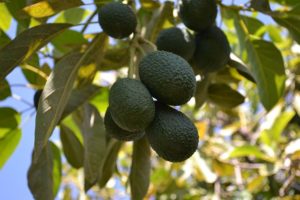 Avocados are considered a fruit and are somewhat unique because they mature on the tree, and then ripen once they are off the tree. They meet all the botanical criteria for a berry, with fleshy pulp that surrounds a seed. When you start thinking of avocados as a fruit, it will help you realize they go way beyond guacamole…there are so many amazing ways to enjoy them including in smoothies and desserts…such as our Chocolate Peanut Butter Pudding!
Avocados are considered a fruit and are somewhat unique because they mature on the tree, and then ripen once they are off the tree. They meet all the botanical criteria for a berry, with fleshy pulp that surrounds a seed. When you start thinking of avocados as a fruit, it will help you realize they go way beyond guacamole…there are so many amazing ways to enjoy them including in smoothies and desserts…such as our Chocolate Peanut Butter Pudding!
Avocados are considered native to central Mexico and Guatemala, with the exception of the Hass avocado, which is the most popular variety and originates in California. Hass avocados can trace their roots back to the 1920’s when a postman, named Rudolph Hass, planted a seedling for the original Hass avocado tree in his orchard in La Habra Heights, California. The Hass avocado became popular and highly desired because of its high quality — people preferred its richer and nuttier taste compared to the industry standard at the time. Now, Hass avocados make up the majority of avocados eaten worldwide today.
Why avocados?
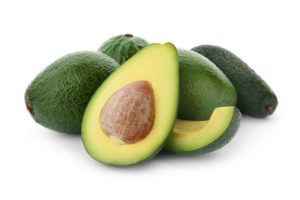 Avocados are loaded with nutrients and vitamins that have huge health benefits, but let’s first address what everyone is thinking…”aren’t they high in fat?”
Avocados are loaded with nutrients and vitamins that have huge health benefits, but let’s first address what everyone is thinking…”aren’t they high in fat?”
And, you’re right, with their 15 g of fat, avocados are one of the highest-fat plant foods out there. But wait! We are not talking about just any fat…these are healthy fats, and the majority is oleic acid, which is a heart-healthy monounsaturated fatty acid and a major component in olive oil.
Why are avocados good for you?
- They help reduce inflammation, and can help reduce the symptoms of osteoarthritis.
- Avocados are loaded with antioxidants that promote eye health and act as cancer fighters. Plus, when you include healthy fats from avocados or avocado oil with your veggies, it can dramatically increase the amount of antioxidants and nutrients you absorb.
- Avocados have NO cholesterol and sodium, and their soluble fiber content actually works to significantly reduce your total cholesterol, and improve heart disease risk factors.
- In addition to the soluble fiber, the insoluble fiber in avocados provides gut-friendly bacteria and promotes weight loss because they help you feel full and more satisfied.
How to you select avocados?
 Whether you are whipping up a quick guacamole, adding them to a salad or dressing, or simply layering or spreading them on a sandwich (the REAL mayo), avocados are a great addition to many dishes.
Whether you are whipping up a quick guacamole, adding them to a salad or dressing, or simply layering or spreading them on a sandwich (the REAL mayo), avocados are a great addition to many dishes.
One of the tricks is knowing how to choose an avocado and knowing when it is too ripe, or not ripe enough. There is nothing worse than slimy-brown mess or a rock-hard avocado at mealtime.
How can you tell if an avocado is ripe?
Color can be an indicator (darker color indicates ripeness); however, the best approach is to gently squeeze it. When you press on the avocado, it should “give” slightly, without staying indented. If it feels mushy, it has become overripe. If it is too hard, it is not ripe yet.
If you need to speed up the ripening process, you can place an avocado in a paper bag with an apple or banana for 2-3 days until it is ripe. You can then slow down the ripening process slightly by placing the avocado uncut in the refrigerator for several days. A rotten avocado will be dark brown and very mushy, but an avocado that is just slightly brown, or has just a few small brown spots, is still OK to eat.
How do you cut an avocado?
- Begin to slice the avocado in half lengthwise, until you feel your knife hit the pit in the middle of the avocado.
- Separate the two halves by twisting each half in opposite directions…the pit will be left in one half.
- Options to remove the pit: 1) use a spoon to scoop the pit out, 2) while holding the avocado in one hand, OR while the avocado is lying pit side up on a cutting board, gently whack the sharp edge of your knife directly into the center of the pit, and then use the knife to twist the pit out.
- Holding one half at a time in the palm of your hand, carefully use your knife to cut a checkerboard pattern, or slices, letting your knife stop when it hits the peel (so you won’t cut your hand).
- Then, use a spoon to scoop the diced pieces or slices out of the avocado half.
- Repeat for the other avocado half. Enjoy!
Check out this video where Zonya shows you how easy it is!
Can you freeze avocados?
It is best to enjoy avocados when they are fresh. However, it is possible to freeze avocados. Some believe the texture of thawed avocados after being frozen can be somewhat strange, so depending on your personal preference, it’s best to use frozen and thawed avocados for dressings, guacamole, or a recipe where they are mashed or pureed.
Freezing avocados tends to work best if you freeze them in halves or chopped (with peel and pit removed). To prevent them from being a brown mushy mess, brush or toss them with an acid, such lemon or lime juice, before placing them in a plastic freezer bag. It is also important to make sure you get as much air out of the bag as possible before sealing and freezing — try using a plastic straw to suck the air out if needed. You can freeze avocados for about 6 months, and it is best to let them thaw gradually, for 12-24 hours, in the refrigerator.
Our most frequently asked question…how do you keep avocados from turning brown?
Many of us have heard the “so-called secrets” to prevent avocados from turning brown…”include the pit in the guacamole,” “make sure to use lime or lemon juice,” “cover tightly” or many others. The real reason cut avocados turn brown is because an enzyme in avocados causes the flesh to oxidize when exposed to air. So, the “secret” is to keep air away from the cut avocado to slow down the browning process. Here are a few ideas:
 Cover any cut avocado, guacamole or other dish tightly with plastic wrap or place in an airtight container.
Cover any cut avocado, guacamole or other dish tightly with plastic wrap or place in an airtight container.- Use water as an air-barrier. For example, smooth out the top of your guacamole, pour a very thin layer of water on top, cover and refrigerate. Then, just before serving, pour off the water, stir and enjoy! (We have tried this and it works! It will keep well for 2-3 days.)
- Because acid in citrus juices, such as lemon or lime, do help slow down oxidation, adding them will help, but you also want to try to avoid exposure to air as well for best results.
There are many more uses for avocados than guacamole and avocado toast! Here are just a few ideas!
 Alternative to olive oil. Avocado oil is a great option to use in cooking, especially since the fats in avocado can handle high heat cooking.
Alternative to olive oil. Avocado oil is a great option to use in cooking, especially since the fats in avocado can handle high heat cooking.- Homemade dressing – the Caesar Salad with Avocado Dressing has mind-blowing flavor!
- Avocado Egg Salad
- Crispy Baked Avocado Fries
- Perfect topping for the Southwest Stuffed Sweet Potato.
- Stuff a burger — try a member favorite, the Avocado and Spicy Mayo Stuffed Burgers.
- Roast it! Absolutely delicious in the Cumin Roasted Avocado and Mango Kale Salad.
 Grill it! You can stuff each half with sautéed veggies or slice it and use it as a topping on the Tropical Salmon Sandwich.
Grill it! You can stuff each half with sautéed veggies or slice it and use it as a topping on the Tropical Salmon Sandwich.- Serve it as a salsa! Enjoy the Blackened Salmon with Avocado Cucumber Salsa.
- Add a seasonal spin on your guacamole with the Strawberry Guacamole.
- Create a creamy spicy topping for the Mexican Black Bean Veggie Pizzas.
- Satisfy your sweet tooth with the Chocolate Peanut Butter Pudding!
Take our Superfood Challenge!
Try avocados in a new way at least once a week in June, whether it is adding it to salad, making a dressing, or creating a creamy dessert — you might be surprised how easy it is to make this nutritional powerhouse part of your regular routine!

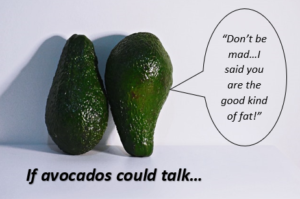
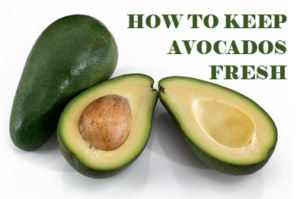
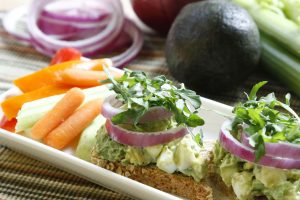
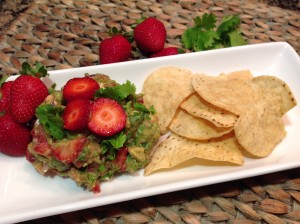
Leave A Comment